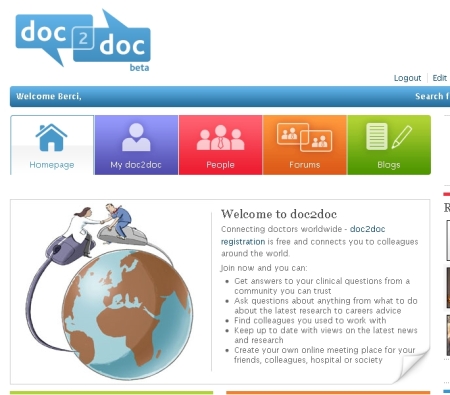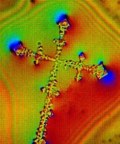The DNA Network |
| The Rise and Fall of Phrenology [Bayblab] Posted: 28 Nov 2008 04:08 PM CST  Recently, my sister sent me a paper she wrote on phrenology to proofread. Being the wonderful older brother that I am, I obliged, after all it's not a subject I'm overly familiar with and it was definitely more up my alley than the women's studies papers I often receive to read the morning they're due. Recently, my sister sent me a paper she wrote on phrenology to proofread. Being the wonderful older brother that I am, I obliged, after all it's not a subject I'm overly familiar with and it was definitely more up my alley than the women's studies papers I often receive to read the morning they're due.For those who didn't grow up in Victorian Europe and are otherwise unaware of this particular "science", phrenology is the determination of a person's personality and mental capacity according to the shape of the skull. Phrenology earned a fair bit of popularity in the early 1800s, but is now (rightly) shunned by the psych and neuroscience communities. The idea behind phrenology stems from the notion that mental functions are localized to discrete areas of the brain. German physiologist Franz Joseph Gall's interest in the area was piqued at an early age when he noticed that among his classmates, those with prominent eyes also excelled at verbal memory tasks. He deduced that the frontal lobes were the centre for verbal memory and suggested that the size of a brain region is directly connected to its functional strength. From there it followed that stronger (and therefore larger) areas would create bulges in the skull to match the corresponding bulges in the underlying brain tissue. Using a map of brain function and scalp massage to determine cranial topology, an individual's personality could be assessed. And thus was born phrenology (then called craniology). It was Gall's student, Johann Spurzheim, who really helped the spread of phrenology. He popularized it in the English speaking world and, notably, America, where one of the first Phrenological Societies was established. Spurzheim switched the focus from the anatomical to the social and political applications, appealing to those looking for guidance, and offering people a way to change through mental exercise. Interest in the technique picked up, largely due to the innate human desire to understand - and predict - oneself. We can still see this today with the inordinate interest in things like fortune cookies, psychic readings, palmistry and astrology. The trend then, as now, was for man to try to rationally explain his own behaviours. Gall's craniology provided a tool understand, predict and maybe even control human behaviour and its popularity began to snowball.  In the US, popularity was booming. Journals such as the American Phrenological Journal granted legitimacy to the practice, earning praise from the likes of Thomas Edison and Alfred Russell Wallage, and the businesses popping up popularized it through talented salesmanship. The Fowler brothers turned phrenology into big business in the tradition of the great snake-oil men, with an entertaining and riveting show advising individuals on all aspects of their lives, from love lives to employment prospects, and ending each show with a practical demonstration. Phrenology had established itself both as a science and in the public mind as a legitimate industry. In the US, popularity was booming. Journals such as the American Phrenological Journal granted legitimacy to the practice, earning praise from the likes of Thomas Edison and Alfred Russell Wallage, and the businesses popping up popularized it through talented salesmanship. The Fowler brothers turned phrenology into big business in the tradition of the great snake-oil men, with an entertaining and riveting show advising individuals on all aspects of their lives, from love lives to employment prospects, and ending each show with a practical demonstration. Phrenology had established itself both as a science and in the public mind as a legitimate industry.Obviously, the shine of phrenology didn't last forever - it certainly isn't an acceptable specialty at any medical school I'm aware of. It was a combination of things that contributed to its downfall. While phrenology was enjoying popularity in North America, it was coming under attack across the pond. One of the primary figures challenging the science was Peter Mark Roget, the English physician famous for his contributions to Encycolopedia Britannica and the eponymous Roget's Thesaurus. Roget, and others, disputed phrenology on both methodological and physiological grounds. The first objection raised was against the very underpinnings of the phrenological movement. While the field was predicated on skull topology being directly related to brain topology, there was no evidence of a connection between the two. In fact, whether 'high energy' (i.e. more developed) parts of the brain were quantitatively larger was the object of dispute, nor could the hypothetical sub-organs being proposed by phrenologists to explain their science be observed on dissection. On top of physiological arguments, phrenology fell prey to the classic fallacy of equating correlation with causation. Phrenology was also under assualt from outside the scientific community, with religious leaders taking aim. Central to the phrenological 'science' was materialism, which is in contrast to the church's position of mind-body dualism. That is, the idea that personality and behaviour is strictly a consequence of the physical attributes of the brain is contrary to teachings of a soul. As a result, phrenology was condemned as implicit atheism. This, coupled with growing rejection in the scientific community and waning novelty of the practice led to the disappearance of phrenolgy and its being discarded as a credible science. Now, there are other pseudosciences that have a similar history to phrenology, yet they endure. Astrology, for example, was widely accepted as reality. It was (and continues to be) opposed by religious leaders and has been rejected as a real science. However, astrology columns can still be found in any newspaper. Likewise, you can still get a tarot card reading, have your palm read or visit a psychic very easily. How is it that they persist but phrenology did not? There are a couple of reasons that might be. First is its short history. Compared to the other pseudoscience mentioned above, phrenology was a flash in the pan. It may not have had time to establish itself in the public consciousness in the .jpg) same way that astrology was able to. Furthermore, despite the poor methodology and basis in reality, phrenology was a scientific endeavor. Being such, results couldn't be rationalized with occult-based explanations. If predictions were wrong, the theory was invalidated. Phrenology was pushed out in favour of other ideas of self, such as the psychoanalysis of Freud or Jung. More importantly, some aspects of phrenology were absorbed into the body of scientific thought, making it easier to discard the invalid ideas. Modern neuroscience obviously still holds a material view of the mind, but the idea of localized functions and specialty areas - the basis of phrenology - have also survived. Every fMRI lighting up the music centre of the brain, for example, owes itself in part to phrenology - the brain science of its day. (Some have even suggested that functionl imaging is the phrenology of the 21st century) Despite having gone the way of the dodo, the study of phrenology remains an interesting piece of science history whose influence can still be seen. same way that astrology was able to. Furthermore, despite the poor methodology and basis in reality, phrenology was a scientific endeavor. Being such, results couldn't be rationalized with occult-based explanations. If predictions were wrong, the theory was invalidated. Phrenology was pushed out in favour of other ideas of self, such as the psychoanalysis of Freud or Jung. More importantly, some aspects of phrenology were absorbed into the body of scientific thought, making it easier to discard the invalid ideas. Modern neuroscience obviously still holds a material view of the mind, but the idea of localized functions and specialty areas - the basis of phrenology - have also survived. Every fMRI lighting up the music centre of the brain, for example, owes itself in part to phrenology - the brain science of its day. (Some have even suggested that functionl imaging is the phrenology of the 21st century) Despite having gone the way of the dodo, the study of phrenology remains an interesting piece of science history whose influence can still be seen. |
| Doc2doc: Community Site from BMJ Group [ScienceRoll] Posted: 28 Nov 2008 01:00 PM CST It’s very important for medical journals and groups to be open to the opportunities web 2.0 provides. BMJ group made a good step and created Doc2doc, a medical community site. But to be honest, I don’t see now why and how it’s different from other community sites. Why should I join? According to their mission statement:
The functions:
Nothing new, nothing innovative. But at least, they made another important step towards health 2.0 Check my extended list of medical community sites for more.  |
| What can science networking online do for you: Slideshow [ScienceRoll] Posted: 28 Nov 2008 12:28 PM CST |
| GlucoBoy: Great Idea in Diabetes Management [ScienceRoll] Posted: 28 Nov 2008 12:17 PM CST Kerri will certainly like this tool, GlucoBoy that represents the power of a good idea in chronic disease management.
 |
| Posted: 28 Nov 2008 12:12 PM CST Mark Ptashne, whose book we looked upon as The Bible of Gene Regulation when I was in graduate school, is featured in a New Yorker article on violin collecting:
|
| Translational Medicine, Cancer and Biobanks: Predictive Health Ethics Events at IU [PredictER Blog] Posted: 28 Nov 2008 11:56 AM CST On December 1-2, 2008 the Indiana Health Industry Forum will present From Basics to Bench to Bedside: Emerging Trends and New Developments in Cancer Discovery, Diagnosis and Treatment. The purpose of this summit, the third in a series, is to examine the state of life sciences research in Indiana with a diverse range of individuals and institutions interested in cancer research, diagnosis and treatment. Of particular interest to those keen on predictive health is a panel discussion on December 2nd at 1:00 PM entitled "Tailored Therapeutics and Implications for Regulatory Endpoints." Panelists include Jerome Yates, MD, MPH, National Vice President for Research at the American Cancer Society, Eric Meslin, PhD, Director of the Indiana University Center for Bioethics (IUCB), Lawrence Lesko, PhD, FCP, Director of the Office of Clinical Pharmacology at the FDA's Center for Drug Evaluation and Research, and Silvana Borges, MD, Medical Officer for the Genomics Group of the same. On December 4, 2008 the Indiana Clinical and Translational Sciences Institute and IU Simon Cancer Center are hosting a symposium entitled Biorepositories: Scientific, Technical and Ethical Considerations at the Cancer Research Institute on the Indiana University – Purdue University Indianapolis campus. IUCB Faculty Investigator Jennifer Girod, JD, PhD, RN, will be giving a talk on "Ethical and Legal Considerations in Biobanking." Other presentations will address issues specific to the storage of biospecimens, the extraction and processing of RNA and DNA, tissue procurement, the impact of storage conditions on DNA, and the benefits of biorepositories to research. On December 8- 9, 2008 the Indiana University School of Medicine will be holding an event that addresses the FDA in the 21st Century: Issues and Their Impact on Medical Technology. This event, which will focus on the future role of the FDA in a changing market, is part of the medical school's Medical Technology Leadership Forum [Flyer - PDF]. IUCB Director Eric Meslin, PhD, will be moderating a morning session on December 9th specific to ethics and conflicts of interest with Ora Pescovitz, MD, President and CEO of Riley Hospital for Children and Elazar Edelman, MD, PhD, Director of the Harvard-MIT Biomedical Engineering Center. – Amy Lewis Gilbert |
| The Research Cooperative - a social networking site for science communication [The Daily Transcript] Posted: 28 Nov 2008 11:03 AM CST Our Seed Overlords alerted us bloggers to this group, and thought I would pass on the information to you. The Research Cooperative, is a non-profit organization whose mission is to bring together researchers, science writers, research editors, translators and publishers. Need someone to translate your manuscript? or just a proofreader? Want to write a book and need an agent? Or need some help with an illustration? Then this is the site for you. Visit the Research Cooperative at http://cooperative.ning.com/. And don't forget to register and create your own profile, here's mine. |
| Medicine Meets Virtual Reality 17: Simulation in Second Life [ScienceRoll] Posted: 28 Nov 2008 10:55 AM CST I write a blog for the conference and publish a series of interviews with famous participants. The second interviewee is Dr. James Kinross and the topic is medical simulations in Second Life. Check it out! Further reading:  |
| Thanksgiving Leftovers: Under the Microscope [Discovering Biology in a Digital World] Posted: 28 Nov 2008 09:00 AM CST Would you recognize your leftovers when they're magnified? Would you know turkey if you saw it at 40X? Make a guess and click an image to see the answer. Reposted from DigitalBio's greatest hit collection technorati tags: Thanksgiving, food science, microscopy Read the rest of this post... | Read the comments on this post... |
| Religious Faith in Technology [Sciencebase Science Blog] Posted: 28 Nov 2008 03:15 AM CST
However, another climate change conference with a difference also begins today in Sweden. That conference hopes to address the issues from a religious rather than a scientific angle with Christians, Muslims, Jews, Chinese Daoists and a native American representative, among others, taking part in the two-day event, which is the first of its kind, apparently. It is timely then that a new scientific study of technology among religious people is to be published in the first 2009 issue of the International Journal of Innovation and Learning. The paper found that technological uptake seems to hint that the apparently more trusting character of many religious people makes them more accepting of new technologies. Though it pains me to say it, could religious faith by our saving grace? If the devout are more inclined to trust new technology, then perhaps they will embrace more quickly novel suggestions for tackling the global issue of climate change. Or, does the research simply reveal that this trusting benevolence apparently associated with “being religious simply means that the devout are not quite so cynical of the hidden agendas of others, which make them more susceptible to the wiles of scammers, spammers, and charlatans. The research paper discusses a relatively small-scale study into the link between strength of religious belief and how this relates to technology acceptance. The researchers wanted to find out whether people of faith are likely to be more trusting of commercial websites than other people. With increasing commercial globalisation and international travel, the advent of the internet and online communities, the concept of social trust has become a key focus of research. Social trust In this context, they used a standard Technology Acceptance Model (TAM) to track online behaviour among a group of users and combined the data with results from an assessment of religious faith known as the Santa Clara Strength of Religious Faith instrument. The aim being to see how faith, trust, and technology mesh in the modern world. The researchers questioned 161 current and former postgraduate university students and others with varying levels of internet experience and different religious convictions. They assessed religious strength based on dedication to prayer and how much a person’s faith plays a role in each individual’s daily life. Attitudes to ecommerce were assessed by testing their interaction with an experimental ecommerce website and asking whether users felt the website operated with their best interests in mind and whether it is run competently and sincerely. An analysis of the results suggests that fundamentally religious faith increases benevolence, which in turn influences perceived ease of use, perceived usefulness and behavioural intention. The more religious were more trusting, it seems. Although one might suggest that this would imply gullibility, the researchers extrapolate their findings to say that communities with strong religious faith may be among the leaders rather than the followers when it comes to technology acceptance, the early adopters in other words. Those people may be the ones paving the way for less trusting and accepting individuals. The researchers say that it is surprising that religion, given its cultural prominence in some parts of the world, has been largely overlooked in studies of this kind. They hope that the present research will enthuse sociologists, economists, and business experts to investigate more closely how religious faith might affect internet use, with a view to improving the experience. But, the big question of the day is who will you be listening to, the scientists virtualised in second life or those people of faith in Sweden? Stuart J. Barnes (2009). Strength of religious faith, trusting beliefs and their role in technology acceptance International Journal of Innovation and Learning, 6 (1), 110-126 |
| You are subscribed to email updates from The DNA Network To stop receiving these emails, you may unsubscribe now. | Email Delivery powered by FeedBurner |
| Inbox too full? | |
| If you prefer to unsubscribe via postal mail, write to: The DNA Network, c/o FeedBurner, 20 W Kinzie, 9th Floor, Chicago IL USA 60610 | |





No comments:
Post a Comment